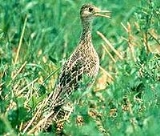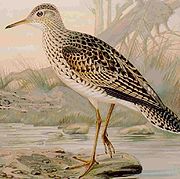
Upland Sandpiper
Encyclopedia

Curlew
The curlews , genus Numenius, are a group of eight species of birds, characterised by long, slender, downcurved bills and mottled brown plumage. They are one of the most ancient lineages of scolopacid waders, together with the godwits which look similar but have straight bills...
s (Thomas, 2004). Older names are the Upland Plover and Bartram's Sandpiper. It is the only member of the genus Bartramia. The genus name and the old common name Bartram's Sandpiper commemorate the American naturalist William Bartram
William Bartram
William Bartram was an American naturalist. The son of Ann and John Bartram, William Bartram and his twin sister Elizabeth were born in Kingsessing, Pennsylvania, near Philadelphia. As a boy, he accompanied his father on many of his travels, to the Catskill Mountains, the New Jersey Pine Barrens,...
. The name "Bartram's Sandpiper" was made popular by Alexander Wilson
Alexander Wilson
Alexander Wilson was a Scottish-American poet, ornithologist, naturalist, and illustrator.Wilson was born in Paisley, Scotland, the son of an illiterate distiller. In 1779 he was apprenticed as a weaver. His main interest at this time was in writing poetry...
, who was taught ornithology and natural history illustration by Bartram.
Description
The adult is 28–32 cm long with a 50–55 cm wingspan. It has long yellow legs and a long neck and tail. The head and neck are light with brown streaks. The back and upper wings are a darker mottled brown and the belly is white.Distribution and habitat
The breeding habitat is open grasslandGrassland
Grasslands are areas where the vegetation is dominated by grasses and other herbaceous plants . However, sedge and rush families can also be found. Grasslands occur naturally on all continents except Antarctica...
s and fields across central North America
North America
North America is a continent wholly within the Northern Hemisphere and almost wholly within the Western Hemisphere. It is also considered a northern subcontinent of the Americas...
and Alaska
Alaska
Alaska is the largest state in the United States by area. It is situated in the northwest extremity of the North American continent, with Canada to the east, the Arctic Ocean to the north, and the Pacific Ocean to the west and south, with Russia further west across the Bering Strait...
; it is not associated with water like other sandpipers. It is a long-distance migrant
Bird migration
Bird migration is the regular seasonal journey undertaken by many species of birds. Bird movements include those made in response to changes in food availability, habitat or weather. Sometimes, journeys are not termed "true migration" because they are irregular or in only one direction...
and winters in South America
South America
South America is a continent situated in the Western Hemisphere, mostly in the Southern Hemisphere, with a relatively small portion in the Northern Hemisphere. The continent is also considered a subcontinent of the Americas. It is bordered on the west by the Pacific Ocean and on the north and east...
. It is a very rare vagrant to Europe, notably the Isles of Scilly
Isles of Scilly
The Isles of Scilly form an archipelago off the southwestern tip of the Cornish peninsula of Great Britain. The islands have had a unitary authority council since 1890, and are separate from the Cornwall unitary authority, but some services are combined with Cornwall and the islands are still part...
, where it can be extremely tame, with at least one bird taking worms from a birder's mouth.
Behavior
Upland Sandpipers forageForage
Forage is plant material eaten by grazing livestock.Historically the term forage has meant only plants eaten by the animals directly as pasture, crop residue, or immature cereal crops, but it is also used more loosely to include similar plants cut for fodder and carried to the animals, especially...
in fields, picking up food by sight. They are frequently sighted on fence posts and even telephone poles. The Upland Sandpiper's diet includes grasshoppers, cricket
Cricket
Cricket is a bat-and-ball game played between two teams of 11 players on an oval-shaped field, at the centre of which is a rectangular 22-yard long pitch. One team bats, trying to score as many runs as possible while the other team bowls and fields, trying to dismiss the batsmen and thus limit the...
s, weevil
Weevil
A weevil is any beetle from the Curculionoidea superfamily. They are usually small, less than , and herbivorous. There are over 60,000 species in several families, mostly in the family Curculionidae...
s, beetles, moths
Moths
Moths may refer to:* Gustav Moths , German rower* The Moths!, an English indie rock band* MOTHS, members of the Memorable Order of Tin Hats...
, ant
Ant
Ants are social insects of the family Formicidae and, along with the related wasps and bees, belong to the order Hymenoptera. Ants evolved from wasp-like ancestors in the mid-Cretaceous period between 110 and 130 million years ago and diversified after the rise of flowering plants. More than...
s, flies, bugs
Hemiptera
Hemiptera is an order of insects most often known as the true bugs , comprising around 50,000–80,000 species of cicadas, aphids, planthoppers, leafhoppers, shield bugs, and others...
, centipedes, millipede
Millipede
Millipedes are arthropods that have two pairs of legs per segment . Each segment that has two pairs of legs is a result of two single segments fused together as one...
s, spiders, snails and earthworms. It also eats some grains and seeds.
Breeding
Upland Sandpipers can sometimes be found in small, loose nesting colonies. The breeding season is from early-to-late summer; nestsBird nest
A bird nest is the spot in which a bird lays and incubates its eggs and raises its young. Although the term popularly refers to a specific structure made by the bird itself—such as the grassy cup nest of the American Robin or Eurasian Blackbird, or the elaborately woven hanging nest of the...
are located on the ground in dense grass
Grass
Grasses, or more technically graminoids, are monocotyledonous, usually herbaceous plants with narrow leaves growing from the base. They include the "true grasses", of the Poaceae family, as well as the sedges and the rushes . The true grasses include cereals, bamboo and the grasses of lawns ...
. The female lays 4 eggs. Both parents look after the young and may perform distraction displays to lure predators away from the nest or young birds.
Call
Upland Sandpipers can be identified by a distinctive call, sometimes called a "wolf whistle", which features a long, ascending whistle followed by a second rising and/or falling call. These sounds are often made while the bird is landing or while flying high.Conservation
The numbers of these birds increased as forests were cleared in the early 19th century, but declined sharply in the late 19th century due to hunting. They are now regularly present in Midwestern North America but populations are scattered in the east.Loss of prairie habitat is a concern. Also, livestock grazing has been found to reduce the number of nests in a field. Controlled burn
Controlled burn
Controlled or prescribed burning, also known as hazard reduction burning or Swailing is a technique sometimes used in forest management, farming, prairie restoration or greenhouse gas abatement. Fire is a natural part of both forest and grassland ecology and controlled fire can be a tool for...
s may benefit this species as they feed on low-growing plants that are more easily spotted after a fire.
External links
- Upland Sandpiper - Bartramia longicauda - USGS Patuxent Bird Identification InfoCenter
- Upland Sandpiper Species Account - Cornell Lab of Ornithology
- Upland Sandpiper Information and Photos - South Dakota Birds and Birding
- Avibase

